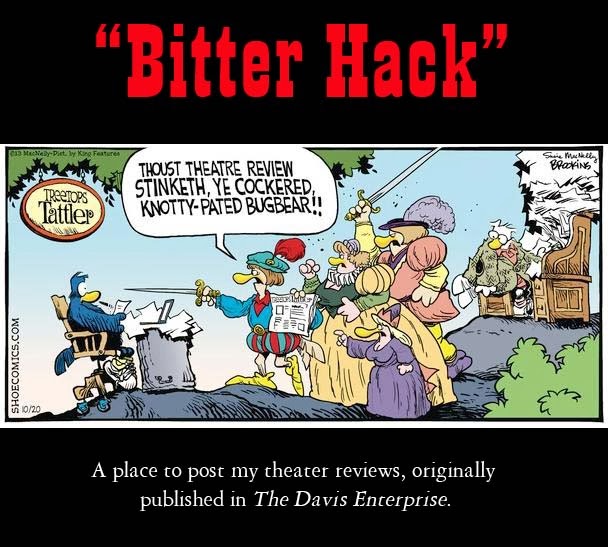 “The Secret Garden” was the Davis Musical Theater show which closed out the company’s time at the Varsity Theater in 2002, prior to moving into the Hoblit Performing Arts Center. I gave it a lukewarm review, pointing to low energy and a bare bones set, which made, particularly, the finale scene very disappointing.
“The Secret Garden” was the Davis Musical Theater show which closed out the company’s time at the Varsity Theater in 2002, prior to moving into the Hoblit Performing Arts Center. I gave it a lukewarm review, pointing to low energy and a bare bones set, which made, particularly, the finale scene very disappointing.I was curious to see what changes I would find six years later, with the company firmly ensconced in their own theater, hoping they would improve on that long-ago production.
They have. In the current production, which opened this weekend at the Hoblit Performing Arts Center, the look is much more plush, the cast consistently good, and the overall evening a delight.
Based on the beloved 1911 book by Frances Hodgson Burnett, "The Secret Garden" tells of Mary Lennox (Kaylynn Rothleder), the only survivor of a cholera epidemic which swept through the family compound in India. She is taken back to England to live with her only remaining relative, her uncle Archibald Craven (Bret McLaughlin), a hunchback who lives in a lonely mansion on a hill in the Yorkshire Moors.
Archibald has been wallowing in deep grief over the death of his wife Lily (Caitlin Kiley), who died in childbirth ten years ago, and has isolated himself from the world, and especially from his sickly son, Colin (Christian Salmon), who is bedridden and kept hidden in his room by his physician, Archibald's brother Neville (Rick Eldredge).
The arrival of Mary, initially a spoiled, self-centered child who has been waited on all her life, causes disruption in the carefully ordered life that Archibald has built for himself.
In her loneliness, Mary begins to explore the grounds and finds secret garden, planted by Lily, and locked ever since her death. With the help of the gardener, Dickon (Joshua Smith), brother of the chambermaid, Martha (Emily Jo Seminoff), Mary works to revive the garden, and in so doing she is herself changed into a caring child who ultimately brings life back to the house, to Archibald and to Colin.
It is helpful to have either read the book or seen the movie (with Margaret O’Brien as Mary) to understand that half of the people on the stage are actually ghosts. This is not a fault of the DMCT production, but of the musical itself, with book and lyrics by Marsha Norman and (mostly forgettable) music by Lucy Simon. The authors seem to take for granted that the audience will already be familiar with the story.
However, whatever the shortcomings of the musical itself, this modest production is quite good.
The bulk of the story and the action rest on the shoulders of Mary Lennox and Kaylynn Rothleder is up to the task. She can be petulant, angry, frightened, and filled with wonder. Rothleder is both a good actress and a good singer, which is half the battle right there.
Bret McLaughlin is a marvelous Archibald Craven. The grief is painfully written on his face in all of the scenes when he remembers his beloved wife. He has a powerful voice, which is equally effective when tender, as in the duet with the ghost of his wife Lily, one of the more poignant in the play.
Caitlin Kiley’s Lily is eloquent and in great voice, and also quite poignant as she interactions with her husband.
Christian Salmon, as Colin, turns in a good performance as Archibald’s son, Colin, being kept in bed by his doctor-uncle who is convinced that to let Colin out of bed would be to shorten his life. He has a good tantrum, and a wonderful wide-eyed wonder look when he sees Mary’s garden.
Rick Eldredge is sufficiently smarmy as Dr. Neville Craven, gradually taking control of Archibald’s house and family for his own reasons.
The supporting cast is quite strong, from Jabriel Shelton, the Fakir in the opening scenes, down to Richard Lui as Ben, the old gardener who is full of wisdom to impart to Mary.
Joshua Smith carries a heavy load as Mary’s friend Dickon, who teaches her how to bring the seemingly dead garden back to life again. Smith has great charisma and you enjoy watching him on stage.
Emily Jo Seminoff is the relentlessly cheerful chambermaid, Martha, Dickon’s sister. Seminoff has a long professional resume and it shows in this role.
Dannette Vassar is the dour Mrs. Medlock, given the task of bringing Mary to Yorkshire. She’s curt and crisp and without much empathy and Vassar is wonderful in the role.
Director Steve Isaacson, who also designed the sets and lights, has greatly improved on his 2002 production. With a cast which is uniformly fine, a more detailed set (the finale is now quite lovely!), and interesting lighting effects, such as the tree on the curtain during one of the later scenes, he has created an enchanting production.
Kudos also go to costume designers Jean Henderson, Anna Johnson and Denise Miles. I particularly liked the assortment of pinafores for Mary.
While its slower pace and complicated themes may not make it a good production for children under the age of 8, older children, especially little girls, should enjoy entering Mary’s secret world and watching how her transformation rubs off on everyone.


